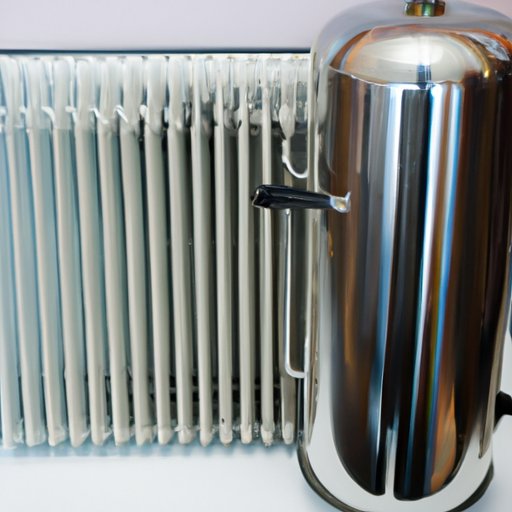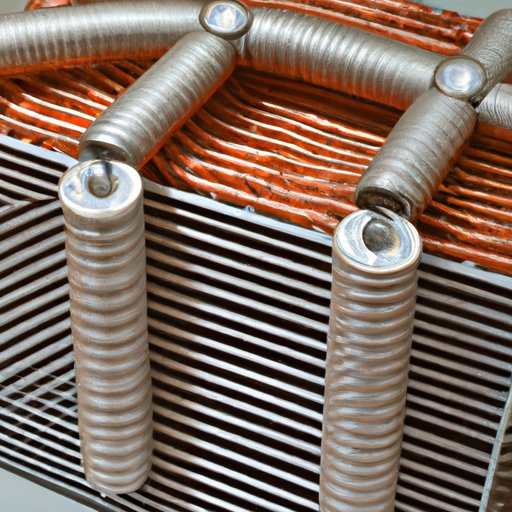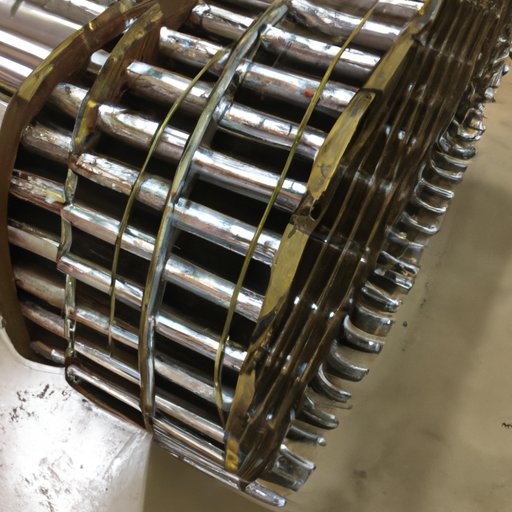Introduction
Heat exchangers are devices used to move thermal energy (or heat) from one medium to another. They are found in a wide range of applications, from industrial manufacturing to everyday life. In this article, we will explore how heat exchangers work, looking at the various components, processes, and types of heat exchangers. We will also examine how heat exchangers are used in everyday life and provide tips for troubleshooting common problems.

Explaining the Basics of Heat Exchangers
To understand how a heat exchanger works, it is important to first understand the concept of heat transfer. Heat transfer is the process by which energy is transferred between two substances or objects due to a difference in temperature. Heat transfer occurs in three different ways: conduction, convection, and radiation.
A heat exchanger is a device that facilitates heat transfer between two fluids or gases. It consists of two separate channels through which the two fluids or gases flow. The two fluids or gases are separated by a wall, which acts as a barrier between them. Heat is transferred from one fluid or gas to the other through the walls of the heat exchanger. As the two fluids or gases flow through the heat exchanger, they exchange thermal energy, resulting in a net transfer of heat.
Heat exchangers have several advantages over other methods of transferring heat. They are relatively inexpensive, efficient, and require minimal maintenance. Additionally, heat exchangers can be used to transfer heat from one medium to another without coming into direct contact with each other. This makes them ideal for applications where contamination or cross-contamination must be avoided.
Examining Different Types of Heat Exchangers
There are several different types of heat exchangers, each designed for a specific application. The most common types of heat exchangers include shell & tube, plate, and air-to-air heat exchangers.
Shell & tube heat exchangers consist of a cylindrical shell containing a series of tubes. One fluid flows through the tubes while the other flows through the shell. Heat is transferred from one fluid to the other through the walls of the tubes.
Plate heat exchangers are composed of multiple plates stacked on top of each other. Each plate has two ports, one for each fluid. Heat is transferred from one fluid to the other through the walls of the plates.
Air-to-air heat exchangers use fans to blow air across a finned surface. Heat is transferred from one air stream to the other through the fins.
Each type of heat exchanger has its own set of advantages and disadvantages. Shell & tube heat exchangers are relatively inexpensive and easy to maintain, but they are not as efficient as other types of heat exchangers. Plate heat exchangers are more efficient than shell & tube heat exchangers, but they are more expensive and require more maintenance. Air-to-air heat exchangers are the most efficient type of heat exchanger, but they are also the most expensive.

How Heat Exchangers are Used in Everyday Life
Heat exchangers are used in a wide range of applications, from industrial manufacturing to everyday life. Common applications for heat exchangers include cooling systems, heating systems, air conditioning systems, refrigeration systems, and water heaters.
For example, car radiators use heat exchangers to transfer heat from the engine coolant to the outside air. Refrigerators use heat exchangers to transfer heat from the inside of the refrigerator to the outside air. Similarly, air conditioners use heat exchangers to transfer heat from the inside of the house to the outside air.

The Components of a Heat Exchanger and their Functions
Heat exchangers consist of several different components, each with its own function. The most common components of a heat exchanger include the heat exchanger core, the inlet and outlet connections, the baffles, and the control valves.
The heat exchanger core is the heart of the heat exchanger. It is responsible for transferring heat from one fluid or gas to the other. The inlet and outlet connections allow the two fluids or gases to enter and exit the heat exchanger. The baffles are used to direct the flow of the fluids or gases within the heat exchanger. Finally, the control valves regulate the flow of the fluids or gases within the heat exchanger.
An Overview of Heat Transfer Processes in a Heat Exchanger
Heat transfer processes occur in a heat exchanger when there is a temperature difference between the two fluids or gases. Heat is transferred from the hotter fluid or gas to the cooler fluid or gas through the walls of the heat exchanger. This process is known as conduction. Convection can also occur if one of the fluids or gases is in motion.
Several factors affect the rate of heat transfer in a heat exchanger. These include the type of heat transfer process, the temperature difference between the two fluids or gases, the size and shape of the heat exchanger, and the material used in the heat exchanger.
Troubleshooting Common Problems with Heat Exchangers
Heat exchangers can develop issues over time due to normal wear and tear. Common problems with heat exchangers include blockages, leaks, and corrosion. In order to identify these issues, it is important to regularly inspect the heat exchanger for any signs of damage or malfunction.
If you suspect that your heat exchanger is malfunctioning, the first step is to isolate the problem. This can be done by checking the temperature of each fluid or gas entering and exiting the heat exchanger. If the temperatures are not within acceptable ranges, then the issue may be related to the heat exchanger itself. Once the problem has been identified, it can usually be resolved with simple maintenance or repairs.
Conclusion
Heat exchangers are versatile devices used to transfer thermal energy from one medium to another. In this article, we explored how heat exchangers work, looking at the various components, processes, and types of heat exchangers. We also examined how heat exchangers are used in everyday life and provided tips for troubleshooting common problems.
(Note: Is this article not meeting your expectations? Do you have knowledge or insights to share? Unlock new opportunities and expand your reach by joining our authors team. Click Registration to join us and share your expertise with our readers.)
